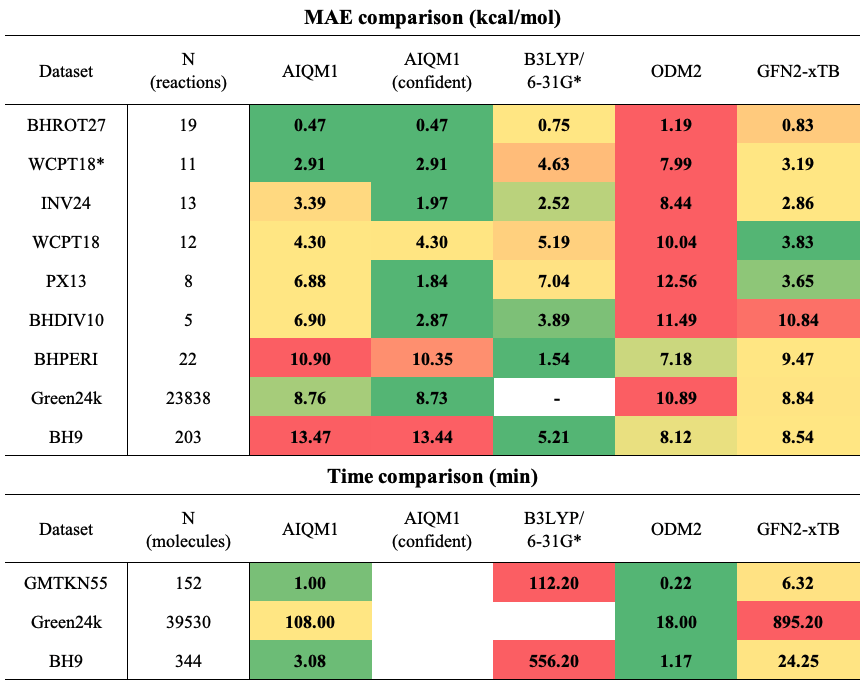Evaluating AIQM1 on Reaction Barrier Heights

In our work published in the Journal of Chemical Physics, we investigate the performance of AIQM1 on reaction barrier heights. Our benchmark results show that, with the built-in uncertainty quantification, the accuracy of confident AIQM1 predictions outperforms its baseline ODM2* method, approaching the level of popular DFT methods for most reaction types but at a significantly reduced computational cost.
Reaction barrier heights are essential for elucidating reaction mechanisms. Traditional quantum mechanical (QM) methods struggle to balance efficiency and accuracy when calculating reaction barrier heights. Advances in artificial intelligence (AI)/machine learning (ML) allow for achieving high-level accuracy with lower cost, often in combination with lower-level, fast quantum mechanical methods. One successful example of such a method is AIQM1, a general-purpose machine learning-based quantum mechanical method, which uses a low-level semi-empirical QM method (modified ODM2*) as the baseline and corrects it with neural networks (NNs). AIQM1 has better accuracy and less cost than popular DFT methods and is approaching coupled-cluster accuracy for ground-state geometries, reaction energies, and enthalpies of formation of closed-shell organic molecules. Its performance on reaction barriers, which involves transition states not included in the training of NNs, has been unclear.
In this work, we explored the performance of AIQM1 on barriers of 8 datasets including in total ca. 24 thousand reactions with neutral and closed-shell compounds containing only CHNO elements. Overall, AIQM1 outperforms its parent semi-empirical QM method ODM2. In most reaction types, AIQM1 has similar accuracy with a popular but hundred times slower B3LYP/6-31G*, although AIQM1 remains inferior to more accurate DFT methods with much larger quadruple-ζ basis sets. The build-in uncertainty quantification of AIQM1 allows to identify confident predictions which generally have much lower errors.

In addition, we found that AIQM1 is robust for transition state geometry optimizations leading to a larger number of successful optimizations and geometries closer to the reference than ODM2 and another popular semi-empirical QM method GFN2-xTB (as the above table shows for the BHPERI data set). Again, a superior speed of AIQM1 compared to DFT and even to the widely-adopted semi-empirical QM method GFN2-xTB makes it suitable for fast transition state optimizations. AIQM1 results can be further refined by performing single-point calculations with high-level QM methods (e.g., coupled cluster) on AIQM1-optimized geometries to obtain reliable reaction barriers even in the most challenging cases for AIQM1 (see MAE in the table above for the BHPERI data set).
In the future AIQM1 can be improved for reaction barrier height calculations by retraining it on more diverse datasets including reaction pathways.
AIQM1 can be accessed via our open-source package for atomistic machine learning simulations MLatom which can be used for free on the XACS cloud computing platform. Tutorials for performing AIQM1 calculation can be found at http://MLatom.com/aiqm1/.
- Yuxinxin Chen, Yanchi Ou, Peikun Zheng, Yaohuang Huang, Fuchun Ge, Pavlo O. Dral*. Benchmark of General-Purpose Machine Learning-Based Quantum Mechanical Method AIQM1 on Reaction Barrier Heights. J. Chem. Phys. 2023, 158, 074103. DOI: 10.1063/5.0137101.
Leave a Reply